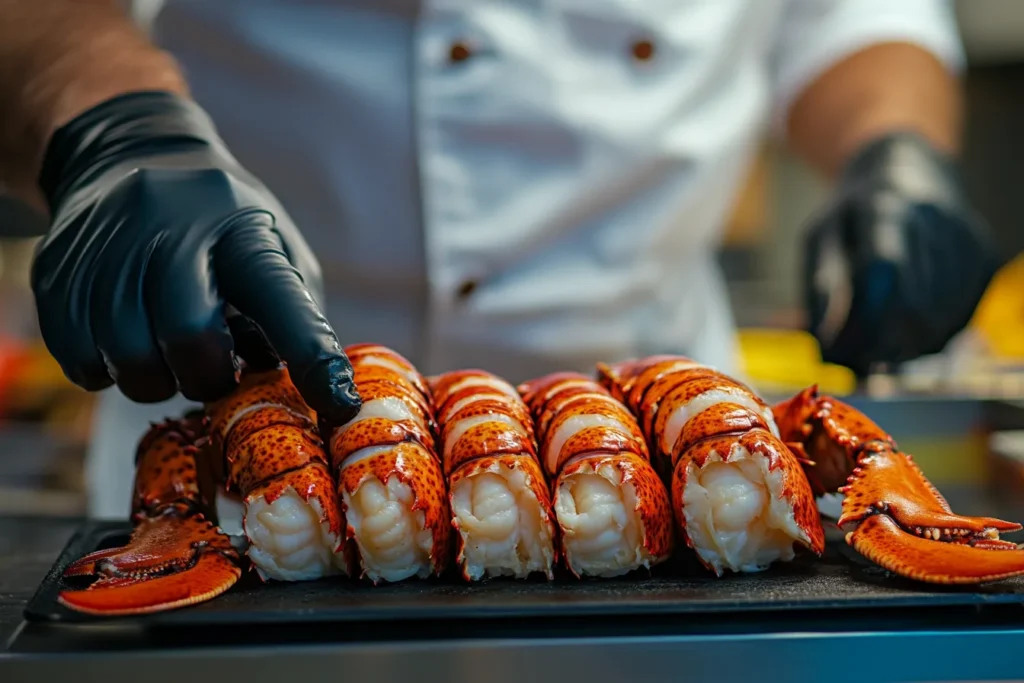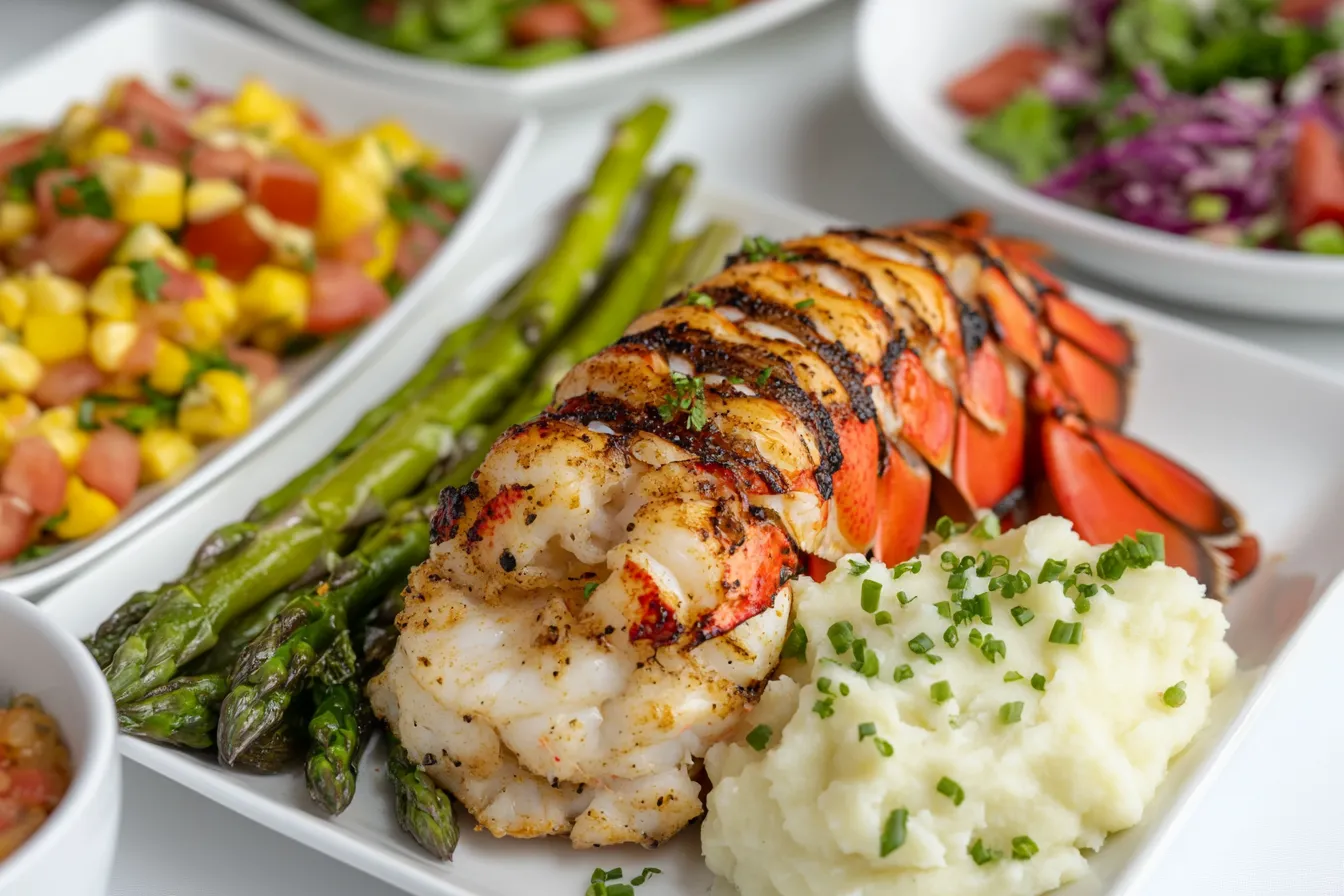Lobster tail recipe options are more diverse and delicious than you might think. This guide will unlock the secrets to cooking perfect lobster tails every single time. Prepare for a culinary adventure!
Table of Contents
Unveiling the Lobster Tail Recipe Fundamentals
A lobster tail recipe is a delightful way to enjoy succulent seafood. Knowing the basics ensures a fantastic dining experience. Fresh or frozen, preparation is key.
First, let’s consider thawing. If using frozen tails, thaw them overnight in the refrigerator for best results. A quick thaw in cold water is acceptable but can slightly affect texture. Pat them dry before cooking.
Next, the crucial step of prepping. Using kitchen shears, cut along the top of the shell, starting from the tail end and stopping just before the body. Gently pry open the shell and loosen the meat.
Seasoning is vital. A simple brush of melted butter, garlic, and herbs elevates the natural sweetness. Paprika adds a touch of color. Salt and pepper are essential.
Cooking methods vary, each offering unique benefits. Baking, broiling, grilling, and boiling are popular choices. Each technique impacts texture and flavor.
Consider your desired outcome. Baking offers even cooking. Broiling provides a caramelized surface. Grilling imparts a smoky flavor. Boiling is quick and easy.
No matter the chosen method, avoid overcooking. Lobster meat becomes tough and rubbery when cooked for too long. An instant-read thermometer is your best friend.
Finally, serving. Lobster tails pair beautifully with a variety of sides. Lemon wedges, drawn butter, and a crisp salad complete the meal. Enjoy your culinary masterpiece!
Exploring Amazing Lobster Tail Recipe Variations
A fantastic lobster tail recipe transcends basic cooking methods. Experimentation unlocks a world of flavor combinations. Let’s explore some amazing variations.
Consider stuffing the lobster tails. A mixture of breadcrumbs, herbs, garlic, and Parmesan cheese creates a savory filling. Bake the stuffed tails until golden brown and bubbly.
Another delicious option is grilling with a citrus marinade. Combine orange juice, lime juice, olive oil, and chili flakes for a zesty kick. Marinate the tails for at least 30 minutes before grilling.
For a creamy indulgence, try lobster Thermidor. This classic dish features lobster meat cooked in a rich sauce of cream, egg yolks, brandy, and Gruyère cheese. It is decadent and unforgettable.
Adding a touch of spice can be exciting. A sprinkle of cayenne pepper or a dash of hot sauce adds a pleasant warmth. Adjust the amount to your preference.
Lobster mac and cheese elevates a comfort food classic. Fold chunks of cooked lobster tail into creamy macaroni and cheese. Top with breadcrumbs and bake until golden brown.
Mastering Different Lobster Tail Recipe Cooking Methods

Different cooking methods dramatically influence the outcome of any lobster tail recipe. Understanding these techniques is crucial for culinary success. Each has its strengths.
Baking lobster tails offers even cooking and tender results. Preheat your oven to 375°F (190°C). Place the prepared tails on a baking sheet. Baste with butter and bake for 12-15 minutes, or until the internal temperature reaches 140°F (60°C).
Broiling provides a quick and easy way to achieve a caramelized surface. Preheat your broiler. Place the prepared tails on a baking sheet. Broil for 5-7 minutes, watching carefully to prevent burning. The internal temperature should also reach 140°F (60°C).
Grilling imparts a smoky flavor and beautiful grill marks. Preheat your grill to medium-high heat. Brush the grates with oil. Grill the tails for 5-7 minutes per side, or until cooked through.
Boiling is a simple and fast method, but it can easily lead to overcooking. Bring a pot of salted water to a boil. Add the lobster tails and cook for 6-8 minutes, or until the shells turn bright red.
Sous vide cooking offers precise temperature control and incredibly tender results. Vacuum seal the lobster tails with butter and herbs. Cook in a water bath at 135°F (57°C) for 30-45 minutes.
No matter the method, use an instant-read thermometer to ensure proper doneness. Overcooked lobster is tough and dry. Aim for an internal temperature of 140°F (60°C).
Consider the size of the tails. Larger tails require longer cooking times. Adjust accordingly. Smaller tails cook more quickly.
Essential Tips for a Perfect Lobster Tail Recipe
Achieving a truly perfect lobster tail recipe involves more than just cooking. These essential tips will elevate your culinary creations to the next level. Small details make a big difference.
First, select high-quality lobster tails. Look for firm, plump meat and bright red shells. Avoid tails that smell fishy or have discolored spots. Freshness is paramount.
Next, consider the source. Maine lobster tails are prized for their sweet flavor and firm texture. However, other varieties can also be delicious. Research your options.
Proper thawing is critical if using frozen tails. Thaw them slowly in the refrigerator to maintain their quality. Avoid thawing at room temperature, as this can promote bacterial growth.
Don’t overcook the lobster tails. Overcooked lobster is tough and rubbery. Use an instant-read thermometer to ensure they are cooked to the correct internal temperature.
Season generously. Lobster meat benefits from flavorful seasonings. Butter, garlic, herbs, and spices all enhance the taste. Don’t be afraid to experiment.
Presentation matters. Serve the lobster tails with elegant sides and garnishes. Lemon wedges, drawn butter, and a sprig of parsley add visual appeal.
Pair the lobster tails with complementary wines. A crisp white wine, such as Sauvignon Blanc or Chardonnay, complements the sweetness of the lobster.
Finally, enjoy the process. Cooking should be a fun and rewarding experience. Relax, experiment, and savor the delicious results.
Avoiding Common Pitfalls in Your Lobster Tail Recipe

Even experienced cooks can encounter pitfalls when preparing a lobster tail recipe. Being aware of these common mistakes can help you avoid them and achieve perfect results. Knowledge is power.
One common mistake is overcooking. Overcooked lobster is tough and rubbery. Use an instant-read thermometer to ensure the tails are cooked to the correct internal temperature.
Another pitfall is under-seasoning. Lobster meat can be bland if not properly seasoned. Don’t be afraid to use generous amounts of butter, garlic, herbs, and spices.
Improper thawing can also negatively impact the texture of lobster tails. Thaw frozen tails slowly in the refrigerator. Avoid thawing at room temperature.
Failing to remove the intestinal vein is another common mistake. This dark vein runs along the back of the tail and can have a bitter taste. Remove it before cooking.
Using old or rancid butter can ruin the flavor of the lobster. Use fresh, high-quality butter for the best results. Clarified butter is a great option.
Skipping the pre-cooking preparation can also lead to problems. Score the shell of the lobster tail before cooking to prevent it from curling up. This also helps the meat cook evenly.
Finally, neglecting the sides can detract from the overall dining experience. Choose sides that complement the flavor of the lobster, such as a crisp salad or roasted vegetables.
Decadent Sides to Enhance Your Lobster Tail Recipe
A truly memorable lobster tail recipe is enhanced by the perfect side dishes. These decadent options will complement the richness of the lobster and create a complete culinary experience. Complementary flavors are crucial.
Consider a classic side of drawn butter. Clarified butter, warmed and served with lemon wedges, is a simple yet elegant accompaniment to lobster.
Roasted asparagus is another excellent choice. The slightly bitter flavor of the asparagus contrasts beautifully with the sweetness of the lobster.
Creamy mashed potatoes provide a comforting and satisfying side dish. Infuse the mashed potatoes with garlic and herbs for added flavor.
A crisp Caesar salad offers a refreshing contrast to the richness of the lobster. The tangy dressing and crunchy croutons create a delightful texture.
Grilled corn on the cob is a summertime favorite that pairs perfectly with lobster. Brush the corn with butter and herbs before grilling for extra flavor.
Risotto is a decadent and flavorful side dish that complements lobster beautifully. Saffron risotto is a particularly elegant choice.
Finally, consider serving lobster tails with a side of truffle fries. The earthy flavor of the truffle oil elevates the meal to another level.
Lobster Tail Recipe: Health Benefits and Nutritional Value
Beyond its exquisite taste, a lobster tail recipe offers various health benefits and nutritional value. Understanding these advantages can make your culinary indulgence even more satisfying. Nutrition is important.
Lobster is a good source of protein, essential for building and repairing tissues. Protein also helps you feel full and satisfied, which can aid in weight management.
Lobster is low in fat and calories, making it a healthy option for those watching their waistlines. It’s a lean protein source that won’t weigh you down.
Lobster is rich in omega-3 fatty acids, which are beneficial for heart health. Omega-3s can help lower cholesterol levels and reduce the risk of heart disease.
Lobster contains selenium, an antioxidant that helps protect cells from damage. Selenium also plays a role in immune function and thyroid health.
Lobster is a good source of vitamin B12, which is essential for nerve function and red blood cell production. Vitamin B12 deficiency can lead to fatigue and other health problems.
Lobster also provides minerals like calcium, magnesium, and phosphorus, which are important for bone health. These minerals help maintain strong and healthy bones.
However, lobster is also high in cholesterol. Individuals with high cholesterol should consume it in moderation.
FAQ
What is the best way to cook lobster tails?
The best way to cook lobster tails depends on your preference. Baking provides even cooking, broiling offers a caramelized surface, grilling imparts a smoky flavor, and boiling is quick and easy. Experiment to find your favorite method.
Is it better to boil or bake lobster tails?
Both boiling and baking can yield delicious results. Boiling is faster, but it’s easy to overcook lobster this way. Baking offers more even cooking and tender results, making it a slightly more foolproof method.
How healthy is lobster tail?
Lobster tail is a good source of protein, omega-3 fatty acids, and selenium. It’s low in fat and calories. However, it’s also high in cholesterol, so it should be consumed in moderation.
What goes well with lobster tails?
Lobster tails pair well with a variety of sides, including drawn butter, roasted asparagus, mashed potatoes, Caesar salad, grilled corn on the cob, and risotto. Lemon wedges and fresh herbs also enhance the presentation.

